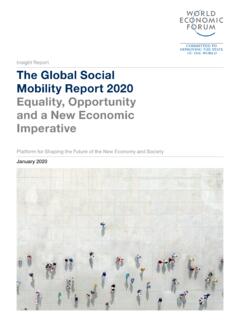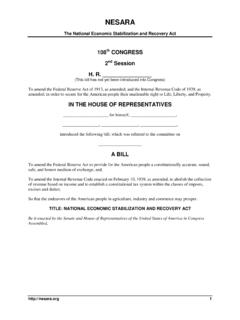Transcription of Women at Work Trends 2016 - International Labour …
1 International Labour Office GenevaWomen at WorkTrends 2016 This publication was produced by the Document and Publications Production, Printing and Distribution Branch (PRODOC) of the ILO. Graphic and typographic design, layout and composition, proofreading, printing, electronic publishing and endeavours to use paper sourced from forests managed in an environmentally sustainable and socially responsible : DTP-WEI-ATAC opyright International Labour Organization 2016 First published 2016 Publications of the International Labour Office enjoy copyright under Protocol 2 of the Universal Copyright Convention. Nevertheless, short excerpts from them may be reproduced without authorization, on condition that the source is indicated. For rights of reproduction or translation, application should be made to ILO Publications (Rights and Licensing), International Labour Office, CH-1211 Geneva 22, Switzerland, or by email: The International Labour Office welcomes such , institutions and other users registered with a reproduction rights organization may make copies in accordance with the licences issued to them for this purpose.
2 Visit to find the reproduction rights organization in your at Work: Trends 2016 International Labour Office Geneva: ILO, 2016 ISBN 978-92-2-130795-2 (print) ISBN 978-92-2-130796-9 (web pdf) International Labour Office Women workers / equal rights / Labour force participation / unemployment / hours of work / Labour market segmentation / wage differential / gender equality / sex discrimination / unpaid work / social protection / family responsibilities / trend / developed countries / developing countries Cataloguing in Publication Data The designations employed in ILO publications, which are in conformity with United Nations practice, and the presentation of material therein do not imply the expression of any opinion whatsoever on the part of the International Labour Office concerning the legal status of any country, area or territory or of its authorities, or concerning the delimitation of its responsibility for opinions expressed in signed articles, studies and other contributions rests solely with their authors.
3 And publication does not constitute an endorsement by the International Labour Office of the opinions expressed in them. Reference to names of firms and commercial products and processes does not imply their endorsement by the International Labour Office, and any failure to mention a particular firm, commercial product or process is not a sign of publications and digital products can be obtained through major booksellers and digital distribution platforms, or ordered directly from For more information, visit our website: or contact at Work. Trends 2016 ContentsContentsPreface viiAcknowledgements ixExecutive summary xiIntroduction 1 Part One.
4 Global and regional trendsI. Background 5II. Labour force participation rates 6A. Narrowing of Labour force participation gaps in most regions 6B. W idening participation gaps in Eastern and Southern Asia 7 III. Employment-to-population ratios 8A. Higher employment-to-population ratios for men 8B. I ncreased share of Women employees 8C. Disproportionate share of Women in contributing family work 10D. Higher proportion of Women in informal employment 11IV. Unemployment rates 12A. Persistent gender gaps in unemployment rates 12B. Higher levels of unemployment among young Women 14V. W orking time for pay or profit and unpaid work 17A. More Women work shorter hours 17B. M ore Women in underemployment 18C. Fewer Women work excessive hours 19D. Longer working days for Women when including unpaid work 19VI. Employment sectors and occupational segregation 22A.
5 Women s employment in services sector has increased 22B. A gricultural sector employs most Women in low- and lower-middle-income countries 23C. In high-income countries Women are concentrated in health, education, wholesale and retail trade sectors 23D. Women have been losing out from recent occupational Trends 25E. No substantial decrease in occupational segregation 26ivWomen at Work. Trends 2016 ContentsVII. Gender wage gap 28A. Substantial gender wage gap but signs of moderate reduction 28B. E conomic growth alone will not ensure a gender equitable distribution of the gains 28 VIII. Gender gaps in access to social protection 30A. Gender inequities in pensions 30B. C overage gaps in maternity protection 35 Conclusion 35 Part Two. Gender gaps in the quality of workI.
6 Sectoral and occupational segregation 39A. Causes of sex segregation at work 39B. G ender gaps in entrepreneurship 40C. Gender gaps in Women s representation in decision-making and leadership positions 41D. Tackling the root causes of sectoral and occupational segregation 421. Encouraging young girls and boys to break gender stereotypes through education and outreach 422. Offering training to Women and men to enter into non-stereotypical fields 433. Promoting Women s entrepreneurship 444. Supporting Women s participation and leadership in decision-making 45II. G ender wage gaps 48A. Persistence of the gender wage gap 48B. How sectoral and occupational segregation perpetuates the gender wage gap 48C. Women s overrepresentation in low-wage jobs 52D. Working time and gender wage gaps 531. Effect of part-time work on Women s earnings and working conditions 532.
7 O verrepresentation of Women among marginal part-time workers 553. Long working hours and the expectation of long working hours 56E. Discrimination: The unexplained component of the gender wage gap 571. Assessing the gender wage gap 572. M otherhood penalty and fatherhood bonus 58F. Addressing the gender wage gap 591. Eliminating unequal treatment of men and Women in the Labour market 592. P romoting equal pay for work of equal value through wage transparency, training and gender neutral job evaluation methods 613. Supporting adequate and inclusive minimum wages and strengthening collective bargaining 624. Promoting and normalizing good quality part-time work 635. L imiting long paid hours and overwork 646. C hanging attitudes towards unpaid care work to overcome the motherhood wage gap 65 III. Work-family policies: The missing link to more and quality jobs for Women 66A.
8 Main Trends and challenges in the provision of an integrated framework of work-family policies 671. Unpaid household and care work as a form of work mainly performed by Women and girls 672. D emographic, social and environmental changes lead to more demand for paid care services 703. Increased enrolment in early childhood care and education in all regions of the world 714. Insufficient coverage, unaffordable costs and problems with quality 725. R apidly ageing population and growing need for long-term care 746. D ecent work deficits in care jobs 75vWomen at Work. Trends 2016 ContentsB. I mplementing a comprehensive approach to harmonize work and family responsibilities 781. Providing maternity protection to all Women according to International Labour standards 802. G uaranteeing adequate social protection to recognize, reduce and redistribute unpaid care work 813. Implementing gender-transformative leave policies: Increasing provision for fathers and their take-up rates 844.
9 Making quality early childhood care and education a universal right 865. C reating and protecting quality jobs in the care economy 896. Promoting decent work for care professionals, including domestic and migrant workers 907. Extending long-term care coverage for older persons 918. Promoting family-friendly flexible working arrangements 919. E ncouraging individual income taxation to boost the participation of Women in the Labour force 9210. Offering work reintegration measures 92 Conclusion 94 Country, regional and income groupings 97 Bibliography 99 Figures1. Gender gaps in Labour force participation rates by region, 1995 and 2015 72. Employment-to-population ratios by sex and by region, 1995 2015 93. Female and male employment status by regions, 1995 and 2015 104. Informal employment as a percentage of non-agricultural employment by sex (latest year available) 115.
10 Unemployment rates by sex and by region, 1995 2015 136. Youth unemployment rates by sex and by region, 1995 2015 158. Time-related underemployment as a percentage of total employment, 87 countries (latest year available) 189. Excessive hours of work: Wage and salaried workers and self-employed working more than 48 hours a week and gender gap, 100 countries (latest year available) 1910. Time spent on paid and unpaid work (for persons in employment, unemployed or inactive) by sex, 65 developing and developed economies (latest year available) 2011. Time spent on paid and unpaid work for employed persons by sex, 46 developing and developed economies (latest year available) 2112. Daily time spent on unpaid work for employed persons by sex, 23 countries and territories (earliest and latest years available) 2113. Employment by sector and by sex, 1995 and 2015 2214. Sectoral employment by sex and change in concentration over time, 1995 2015 2415.













